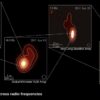A persistent obstacle to a more complete understanding of Earth’s auroral activity is characterizing the structure of auroral arcs in 3D. In situ observations, such as spacecraft transits, can directly observe only a narrow slice of the phenomenon, whereas ground-based images compress the dimensionality into their plane of observation.
Clayton et al. present a new technique that aims to overcome these difficulties by using various observations as constraints for a physical model that then provide a 3D estimate of the feature’s structure. The research team then demonstrated the approach’s ability to describe kilometer-scale plasma structures in the vicinity of an actual auroral arc.
The new technique is built around the Geospace Environment Model of Ion-Neutral Interactions (GEMINI), a 3D ionospheric model. This model is driven with two distinct data sources: particle fluxes and electric field measurements. The particle data are derived from inversions of ground-based images, whereas the field data can be taken from in situ spacecraft observations or from ground-based radar.
The study uses data from a 2017 sounding rocket launch. In situ data are in the form of a 1D line of observed values corresponding to the flight path of the rocket. A key step in the process is converting these data, which cut across the model grid, into a 2D estimate of the plasma flow. Clayton and colleagues present two methods for accomplishing this and compare their relative performances.
Once the data are prepared, GEMINI is run to generate several 3D, time-varying outputs, including the plasma currents and densities. Constrained by the initial, measured data, these outputs are representative of the actual, physical structures surrounding the auroral arc. According to the authors, their work demonstrates that they can glean insight into the relative strength of various physical processes in an auroral environment.
More information:
Robert Clayton et al, Examining the Auroral Ionosphere in Three Dimensions Using Reconstructed 2D Maps of Auroral Data to Drive the 3D GEMINI Model, Journal of Geophysical Research: Space Physics (2021). DOI: 10.1029/2021JA029749
Provided by
American Geophysical Union
This story is republished courtesy of Eos, hosted by the American Geophysical Union. Read the original story here.
Citation:
Converting auroral observations into 3D structures (2022, January 4)



